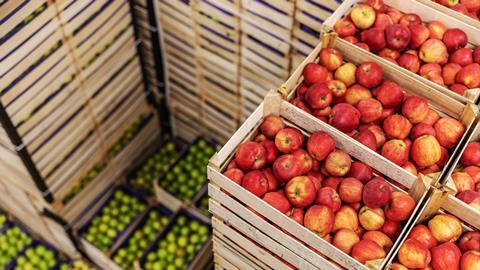Revised forecasts indicate a more modest increase in Southern Hemisphere apple output, as well as a slight decrease in pear volumes
Apple and pear production in the Southern Hemisphere will increase by less than previously expected, after poor weather in several of the region’s major supply countries reduced the size of this season’s crops.
Adverse conditions have affected apple harvests in New Zealand, where Cyclone Gabrielle struck orchards and took out more than one-fifth of the forecast volume; in South Africa, where hailstorms hit key production areas and brought down the average fruit size; and in Australia, where some growers had to contend with flooding and hail events.
According to the World Apple and Pear Association (Wapa), the combined volume of apples across Argentina, Australia, Brazil, Chile, New Zealand, and South Africa is now expected to be just 2.38 per cent higher than last year at 4.97m tonnes. An earlier forecast had this season’s total crop up 6 per cent.
As a result of the intense weather, New Zealand’s apple crop forecast has been revised downward by 77.902 tonnes to 457,675 tonnes, 9 per cent lower than in 2022.
South Africa’s forecast is now 77.276 tonnes less at 1.14m tonnes, down 5 per cent year on year, while Australia will have 8 per cent less this year at 290,000 tonnes.
Chile remains the hemisphere’s largest producer with just under 1.41m tonnes, more of less the same as in 2022.
Brazil’s 1.15m-tonne crop is 12 per cent up on the year, while Argentina’s production should reach 525,000 tonnes, or 24 per cent more than in 2022.
At 1.84m tonnes, Gala remains by far the most widely grown variety, and its production is expected to increase by 4 per cent compared with last season’s figure.
In terms of exports, Wapa said it expected a 3 per cent decrease to below 1.56m tonnes. Chile remains the largest exporter (604,000 tonnes), it said, followed by South Africa (509,158 tonnes), which is set to export 10 per cent less this season.
Exports from New Zealand (286,823 tonnes) and Australia (2,687 tonnes) are also predicted to fall, by 15 per cent and 1 per cent respectively.
In contrast, Brazil’s 70,000 tonnes and Argentina’s 84,000 tonnes represent an increase on last year’s export figures.

Pears pared back
A similar revision to the Southern Hemisphere pear forecast – Argentina, Australia, Chile, New Zealand and South Africa – suggests a 1.25 per cent annual decrease to just under 1.32m tonnes, whereas the initial expectation was a 1 per cent rise.
That change includes an expected reduction of 28,726 tonnes from the initial prediction in South Africa, as well as a small drop (-323 tonnes) in New Zealand.
Argentina (592,000 tonnes) and Chile (170,000 tonnes) are due to increase their production by 4 per cent and 2 per cent respectively.
Meanwhile, South Africa (477,419 tonnes, -6 per cent), Australia (72,016 tonnes, -16 per cent), and New Zealand (8,120 tonnes, -19 per cent) all expect smaller crops.
Packham’s Triumph remains the most widely produced pear variety (481,049 tonnes, in line with 2022), followed by Williams’ Bon Chrétien (332,447 tonnes).
Export figures are expected to be stable (670,054 tonnes), with a 12 per cent increase in Argentinian exports and a 13 per cent decrease in exports from South Africa.
Wapa’s annual report is compiled with help from Asoex (Chile), Cafi (Argentina), ABPM (Brazil), Hortgro (South Africa), Apal (Australia), and New Zealand Apples and Pears.







